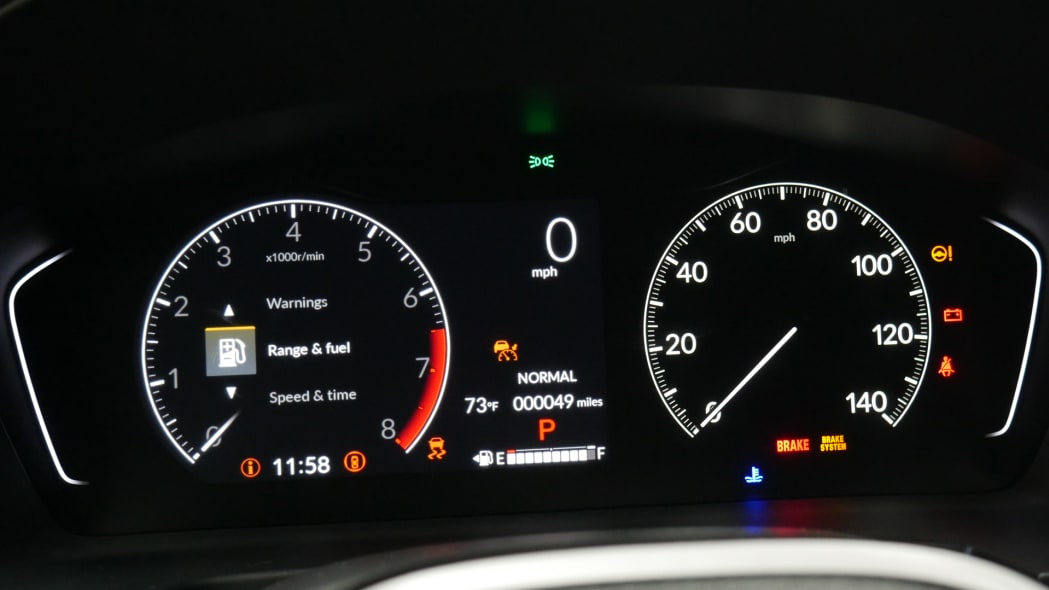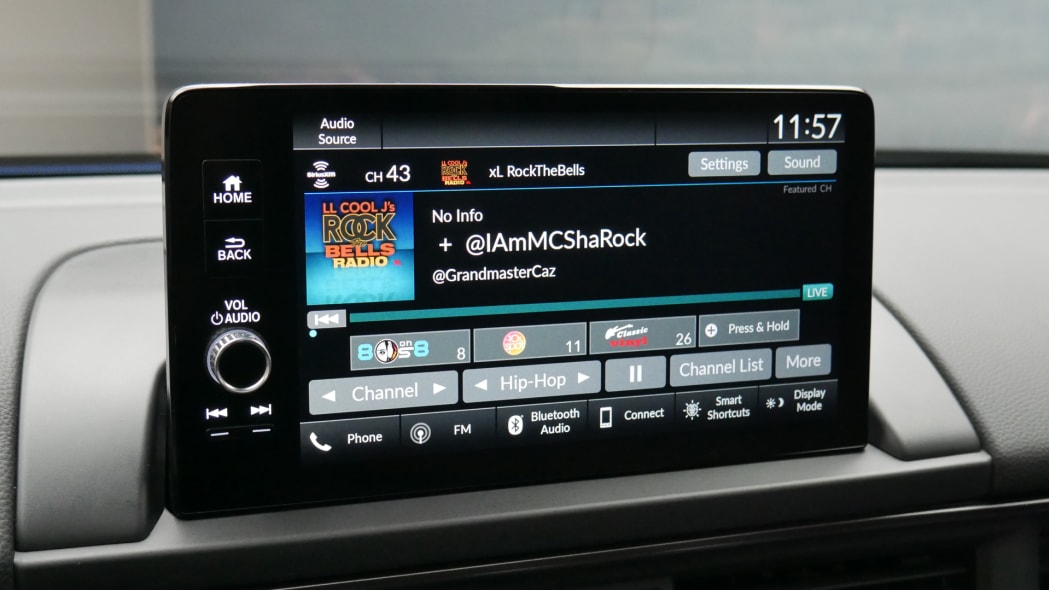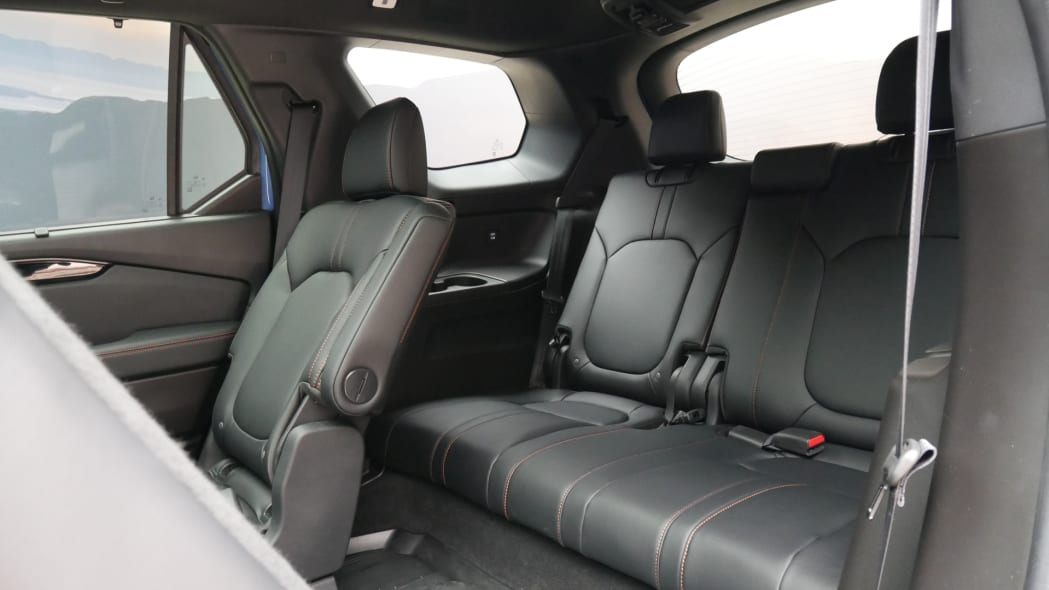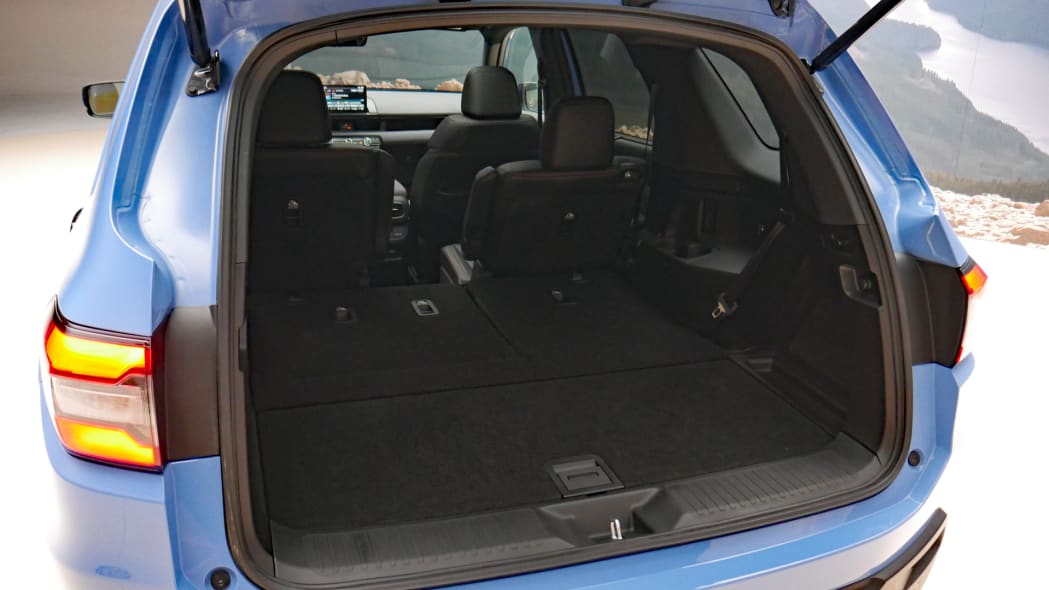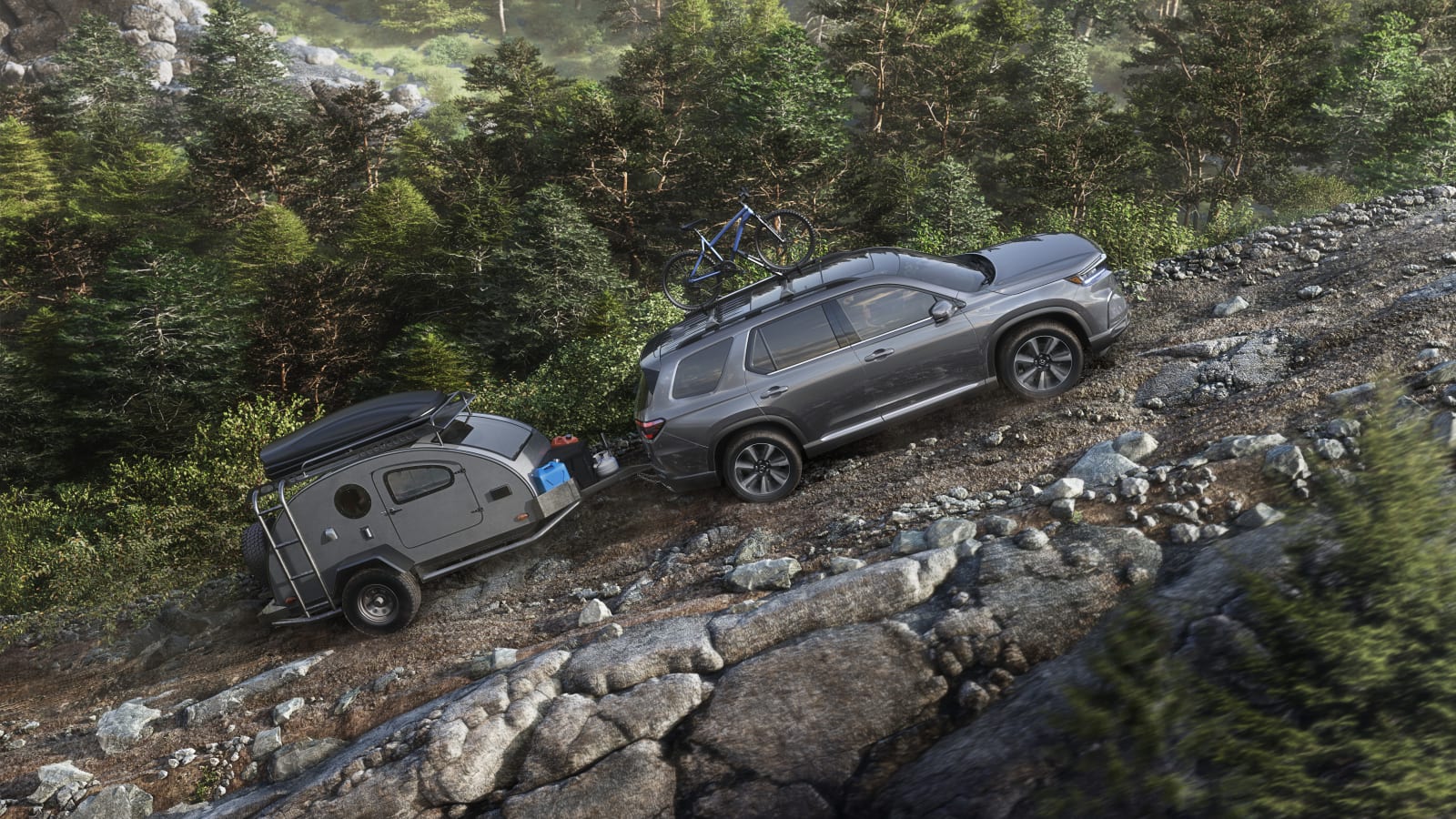Pros: Segment-leading space; unique second-row functionality; refined ride; TrailSport is actually interesting and surprisingly capable
Cons: Thirsty V6 with no hybrid or turbo alternatives
New from the ground up for 2023, the Honda Pilot brings new gadgets and a more purpose-built off-road trim to a segment swiftly growing crowded with both. It’s bigger, quieter, comfier and outfitted with better tech than ever before, once again reminding the world that Honda’s badge is indicative of segment leadership. Then there’s the new TrailSport model, which combines beefier tires and additional ground clearance with Honda’s torque-vectoring all-wheel drive system, taking the outdoor adventure fight to the likes of the Nissan Pathfinder Rock Creek and Ford Explorer Timberline (among others).
Prior to the redesign, the Pilot was one of the more functional choices in the segment, but it suffered from overwhelming plainness with a drab interior, amorphous exterior and a lack of punch-up options for outdoorsy types. The 2023 overhaul addresses those gripes. The new Pilot sports a more cohesive look that’s more square-jawed and intentional, pairing nicely with the dark trim elements offered on the loaded-up Elite and TrailSport trims. The vaguely Land Rover-like interior pairs with it well.
At the same time, it builds upon its predecessors’ practicality, and we’re not talking about ballooning in size. Honda has taken some of the guesswork out of the buying process for families who can’t decide between seven- and eight-passenger seating configurations by offering a removable center seat in the second row that can even be removed on-the-go without the need for extra storage space in your garage. Quality-of-life updates like these help to propel the Pilot to the front of an incredibly tight three-row crossover field.
Interior & Technology | Passenger & Cargo Space | Performance & Fuel Economy
What it’s like to drive | Pricing & Features | Crash Ratings & Safety Features
What’s new for 2023?
The whole thing. The 2023 Pilot represents a culmination of sorts for Honda’s engineers, who just put similar effort into a new Civic, HR-V and CR-V, along with a heavily revised Accord.
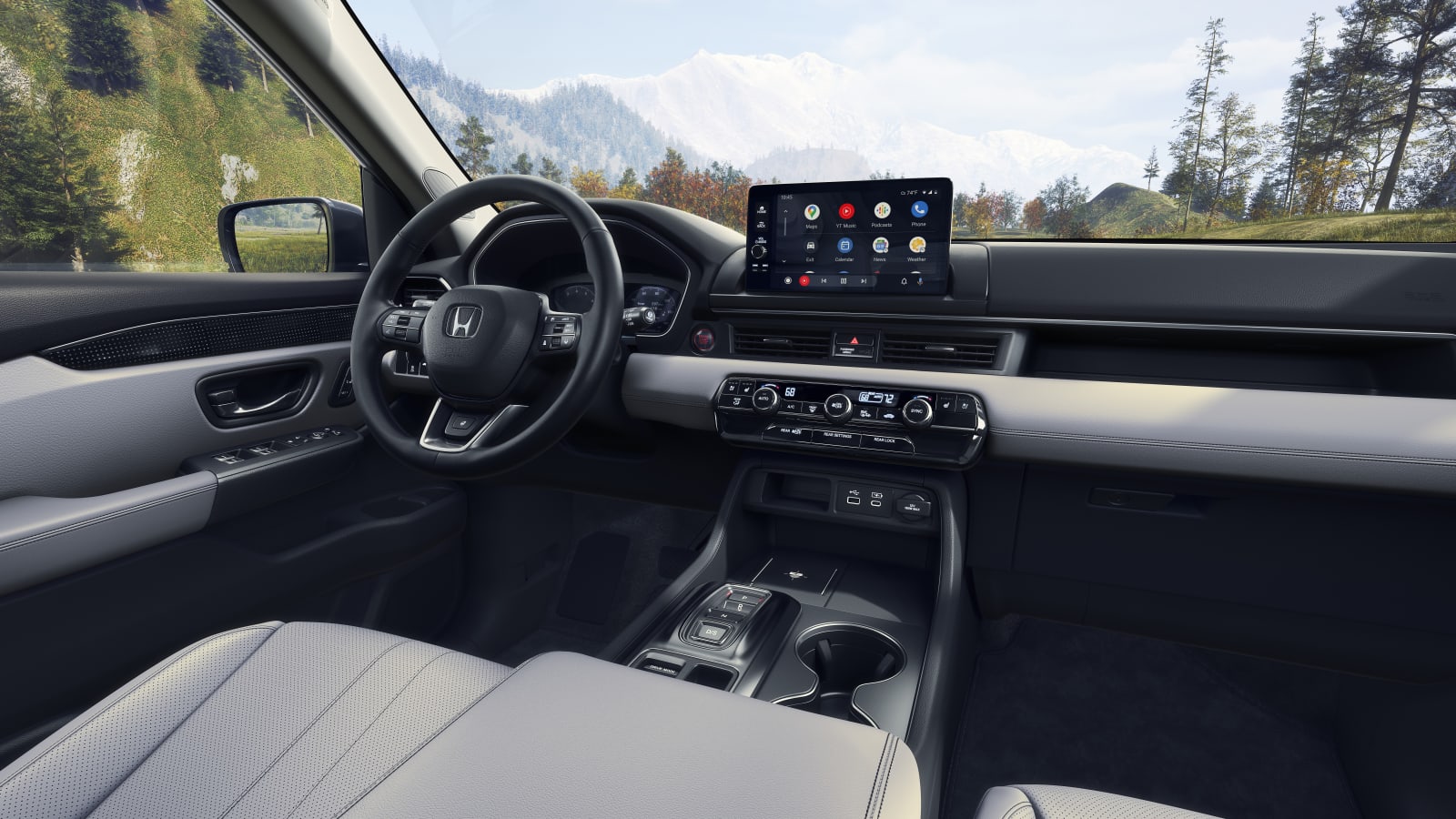
What are the Pilot’s interior and in-car technology like?
Honda chucked the Pilot’s old cabin out the window entirely in favor of a new, much sleeker and more upscale look. The front seats were redesigned for better support and reduced fatigue. Materials, fit and finish all show improvements over the previous generation and help elevate what was a functional if slightly drab cabin to one of the more attractive options in the segment. There’s no under-console storage, but there is ample space inside along with room for doodads in the recessed portion of the dash.
The Pilot finally gets the upgraded infotainment system that showed up on the last-generation Accord (and has since been replaced for the new generation). So although it’s not exactly Honda’s latest and greatest, it’s substantially better than what was in the Pilot before – meaning it’s actually competitive now. Whether you opt for the standard 7-inch infotainment system or the 9-inch upgrade, the physical-button-to-touchscreen-control ratio is favorable. The 10.2-inch digital cluster exclusive to the Elite is cool to look at but doesn’t offer much in the way of additional functionality.
USB-A and USB-C plugs are available on the center console for smartphones, as is a standard 12-volt DC outlet. USB-A charging is also standard in the second row; third-row ports become standard at EX-L and above. The single 3.0-amp USB-C port up front is nice, but we’d like to see more of those in the rear cabin area. Wired Android Auto and Apple CarPlay are standard (wireless is standard on EX-L or better). The new Bose system on the Elite is the first branded audio offered in Pilot’s history and a new TrailWatch camera system features four exterior cameras with four different views.
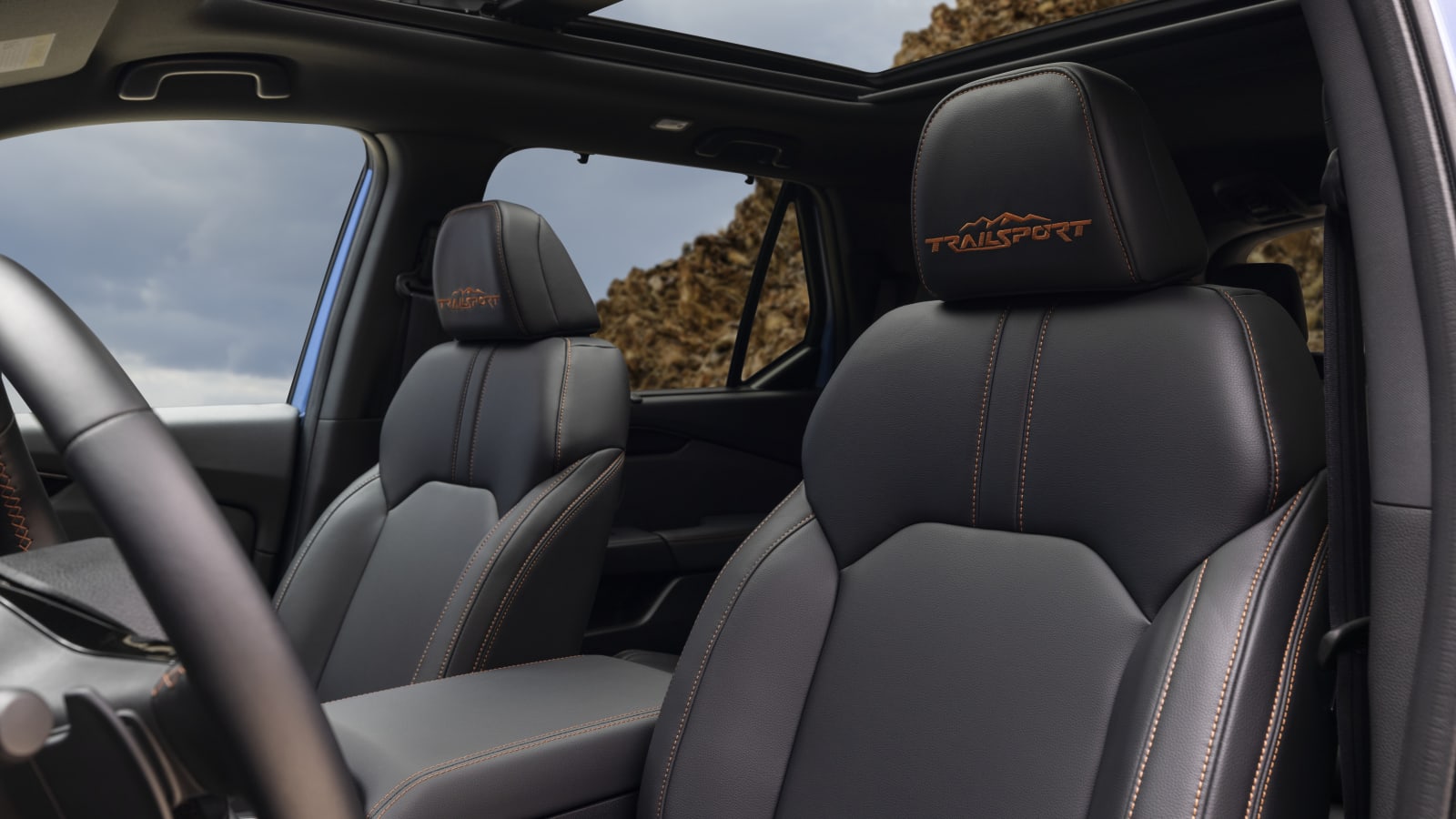
How big is the Pilot?
The new Pilot pretty much defines the segment average. It’s almost 5 inches longer than the Toyota Highlander and 5 inches shorter than the Chevy Traverse, matching up almost identically with the Nissan Pathfinder. This makes it bit more minivan-adjacent inside. That’s especially true of the novel new second-row seating arrangement standard on the Touring and Elite trims. It’s a bench seat, but as in the Odyssey and the Pilot’s Acura MDX cousin, the middle seat folds to create a console-like armrest. It can also be removed completely from the car or, uniquely, stowed in a cubby built into the Pilot’s rear cargo floor. Unlike the Pilot’s competitors, there’s no need to choose between eight-passenger bench seat or seven-passenger captain’s chairs at the dealer, but bear in mind that this feature isn’t offered on the TrailSport. Between the Pilot’s updated all-wheel drive system and the full-sized spare tire (in case you get an off-road puncture), there’s no space for the requisite cubby.
The big Honda has one of the roomer cabins in the segment. Its 40 inches of legroom in the second row tops virtually every one of its competitors. Legroom in the Pilot’s third row grew to a max of 32.5 inches, making it even friendlier for bigger teens and adults, even in the 6-foot-plus category. This puts it ahead of the Toyota Highlander and Nissan Pathfinder (both offer 28 inches) and just behind the Chevy Traverse (33.5 inches).
The cargo area can hold an impressive 22.4 cubic feet, not including the huge underfloor area, which as before, can be utilized to carry even more luggage (or that middle seat). The last-generation Pilot was able to hold far more stuff than its official volume suggested and we would expect the new version can as well, resulting in one of the most spacious and versatile cargo areas in the segment.
What are the Pilot fuel economy and performance specs?
The 2023 Pilot’s V6 engine may appear at first blush to have been carried over basically unchanged from 2022, but is in fact a new DOHC 3.5-liter (in place of the outgoing SOHC mill). Its output of 285 horsepower and 262 pound-feet is up slightly, but not so much you’d notice. A 10-speed automatic returns and is paired with paddle shifters for manual control.
From there, your powertrain options are fairly limited. The Pilot can be had in standard front-wheel drive or all-wheel-drive setup dubbed i-VTM4. Its arguably the most advanced AWD systems in the segment as it provides so-called “torque vectoring”: As much as 70% of the engine’s power can be sent to the rear axle, with 100% of that transferred to one wheel. This is not only beneficial for poor weather traction, but benefits dry pavement handling as well. It’s augmented on TrailSport models with a special Trail Torque Logic system and corresponding “Trail” option in the Pilot’s (also new) drive mode selection system.
Standard FWD models are rated at 19 mpg city, 27 mpg highway and 22 mpg combined. Adding the AWD nudges those downward to 19/25/21. The TrailSport model, with its knobby tires and obstacle-friendly body work, is rated at just 18 mpg city, 23 highway and 20 combined.
The Pilot can be outfitted for towing in both 2WD and AWD configurations. 2WD towing capacity is a reasonable 3,500 pounds; opting for AWD raises that cap to 5,000. That’s on par with the segment, but shy of the Kia Telluride (5,500), Ford Explorer (5,600) and Jeep Grand Cherokee L (6,200).
What’s the Pilot like to drive?
Three-row crossovers aren’t normally known for being tons of fun to drive, but the Pilot holds its own for a gussied-up minivan, especially if you opt for AWD. In fact, despite the potential of increased noise as its knobbier tires wear, we’d pick the TrailSport if you care about the way your people-mover feels. The busier tire tread seems a tad more communicative than the standard all-seasons, adding a slight edge of tactility to what would otherwise be a rather mute helm. Apart from standouts like the Mazda CX-9, this is about as good as it gets in a FWD-based crossover. The Jeep Grand Cherokee and Ford Explorer can both be had with punchier engines to go with their rear-wheel-drive dynamics.
On the road, the Pilot is composed and comfortable. While we might wish for a Highlander-esque hybrid option, the Pilot is certainly better off without the Toyota’s coarse hybrid system. It tracks more steadily on the freeway than the Nissan Pathfinder, Kia Telluride or Hyundai Palisade, and its V6, while perhaps quaint by modern powertrain standards, offers plenty of passing power when called upon.
As for the TrailSport, it gets a unique suspension with a 1-inch lift (for a total ground clearance of 8.3 inches) and improved approach and departure angles. The stabilizer bars, spring rates and damper valve tuning are exclusive to the TrailSport, as are a full-size spare and the 18-inch wheels (stamped with TrailSport) wrapped in Continental TerrainContact all-terrain tires. Skid plates protect the oil pan, transmission and gas tank, and Honda says they can each support the entire weight of the Pilot crashing down on a rock. The result is a vehicle that’s remarkably capable for what is fundamentally little more than a minivan, though like the Pathfinder Rock Creek or Explorer Timberline, it’s not a particularly robust off-roader. It’s the sort of SUV that can bring you all the way to the trailhead, but it won’t let you blaze your own. Those who might find need to do anything beyond the basics would be better served by the three-row Jeep Grand Cherokee L, which is available with a low-range transfer case.
What other Honda Pilot reviews can I read?
2023 Honda Pilot First Drive | Broad strokes and broader shoulders
It’s roomier and more rugged and seems to have something to prove
2023 Honda Pilot First Look: Better looking, more rugged, more family friendly
The new fourth-generation Pilot, including TrailSport, adds style to all that utility
2023 Honda Pilot brings back the DOHC V6 for cleaner emissions
VTEC will not kick in, yo
How much is the 2023 Pilot’s price and what features are available?
The 2023 Pilot LX starts at $37,295 (including a $1,345 destination charge) and comes with standard LED headlights and taillights, 18-inch alloy wheels, a 7-inch infotainment screen with Apple CarPlay and Android Auto and three-zone automatic climate control. The Sport adds power adjustment to the driver’s seat and heat for both front occupants. If you want the larger infotainment system, opt for the EX-L or above. Touring will get you the 12-speaker Bose audio system and the loaded-up Elite is the only to be offered with a HUD.
The standout trim for Pilot is the TrailSport. It’s the only way to get the off-road goodies, described above. Its positioning between the Touring and Elite models conveys a solid equipment suite along with its uniquely rugged look and capability.
Here’s the 2023 Honda Pilot’s pricing broken down by trim:
- LX: $37,295
- Sport: $40,495
- EX-L: $43,295
- Touring: $47,795
- TrailSport (AWD only): $49,695
- Elite (AWD only): $53,375
What are the Pilot’s safety ratings and driver assistance features?
The 2023 Honda Pilot has not yet been rated by either the U.S. government or the Insurance Institute for Highway Safety, but we expect it to fair quite well by both.
Standard safety equipment includes forward collision warning with automatic emergency braking, a road departure mitigation system, lane-departure warning with lane-keeping assist, adaptive cruise control with speed-adaptive following distance, traffic sign recognition, a driver inattention monitor and automatic high beams. Collectively, these features comprise the basic “Honda Sensing” safety suite. Low speed braking control, cross-traffic monitoring and a parking sensor system are all available on higher trims. Importantly, these are greatly improved over the same systems found in the previous-generation Pilot (especially adaptive cruise control), and although not the strongest in the segment (look to Kia and Hyundai for that) they are now at least average.
Related Video


